1993 CHEVROLET CAVALIER jump start
[x] Cancel search: jump startPage 136 of 308
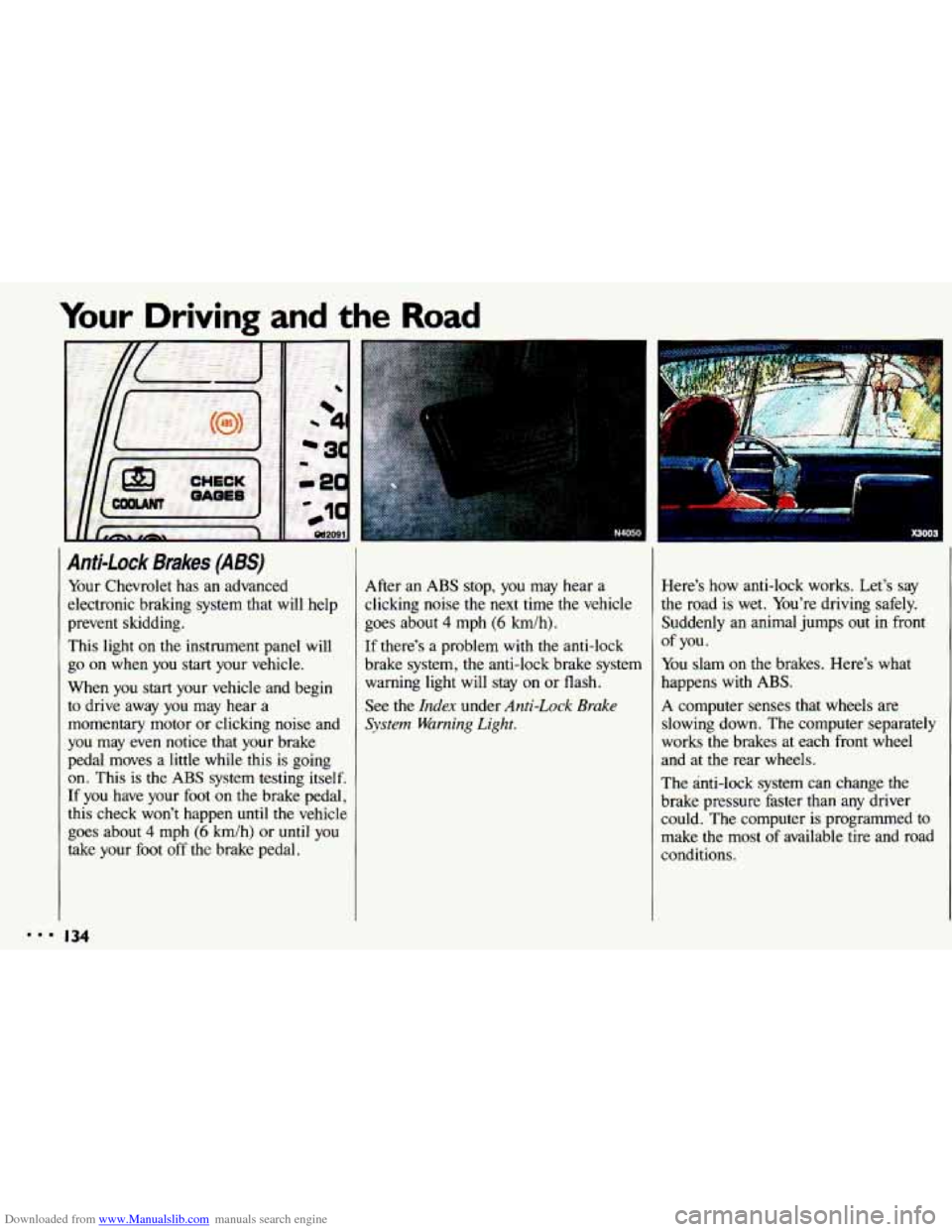
Downloaded from www.Manualslib.com manuals search engine Your Driving and the Road
Anti-Lock Brakes (ABS)
Your Chevrolet has an advanced
electronic braking system that will help
prevent skidding.
This light
on the instrument panel will
go
on when you start your vehicle.
When you start your vehicle and begin
to drive away you may hear a
momentary motor or clicking noise and
you may even notice that your brake
pedal moves a little while this is going
on. This is the ABS system testing itself.
If you have your foot on the brake pedal,
this check won’t happen
until the vehicle
goes about
4 mph (6 km/h) or until you
take your foot
off the brake pedal. After an
ABS stop,
you may hear a
clicking noise the next time the vehicle
goes about
4 mph (6 km/h).
If there’s a problem
with the anti-lock
brake system, the anti-lock brake system warning light will stay on or flash.
See
the Index under Anti-Lock Brake
System Warning Light.
Here’s how anti-lock works. Let’s say
the road is wet. You’re driving safely.
Suddenly an animal jumps out
in front
You slam
on the brakes. Here’s what
happens with ABS.
A computer senses that wheels are
slowing down. The computer separately
works the brakes at each front wheel
and at the rear wheels.
The anti-lock
system can change the
brake pressure faster than any driver
could. The computer is programmed to
make the most of available tire and road
conditions.
of you.
134
Page 165 of 308
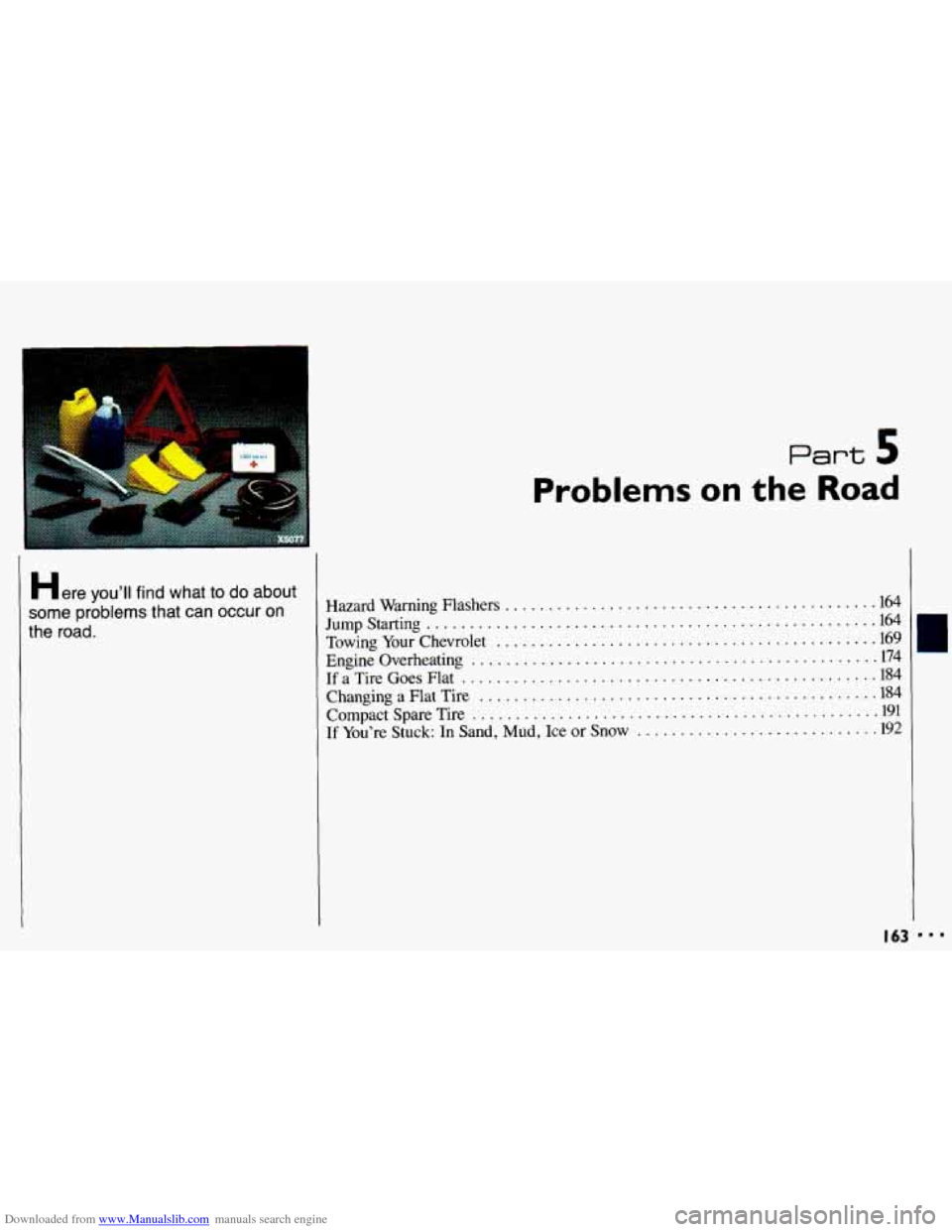
Downloaded from www.Manualslib.com manuals search engine Part 5
Problems on the Road
Hazard Warning Flashers .......................................... .164
Towing Your Chevrolet ........................................... .169
Engine Overheating
.............................................. ,174
If a Tire Goes Flat ............................................... .184
ComDact Spare Tire
.............................................. .191
Jumpstarting
....................................................164
ChangingaFlatTire .............................................. 184
If You’re
Stuck: In Sand, Mud, Ice or Snow ................... ...... .192
Here you’ll find what to do about
some problems that can occur on
the road.
I63
Page 166 of 308
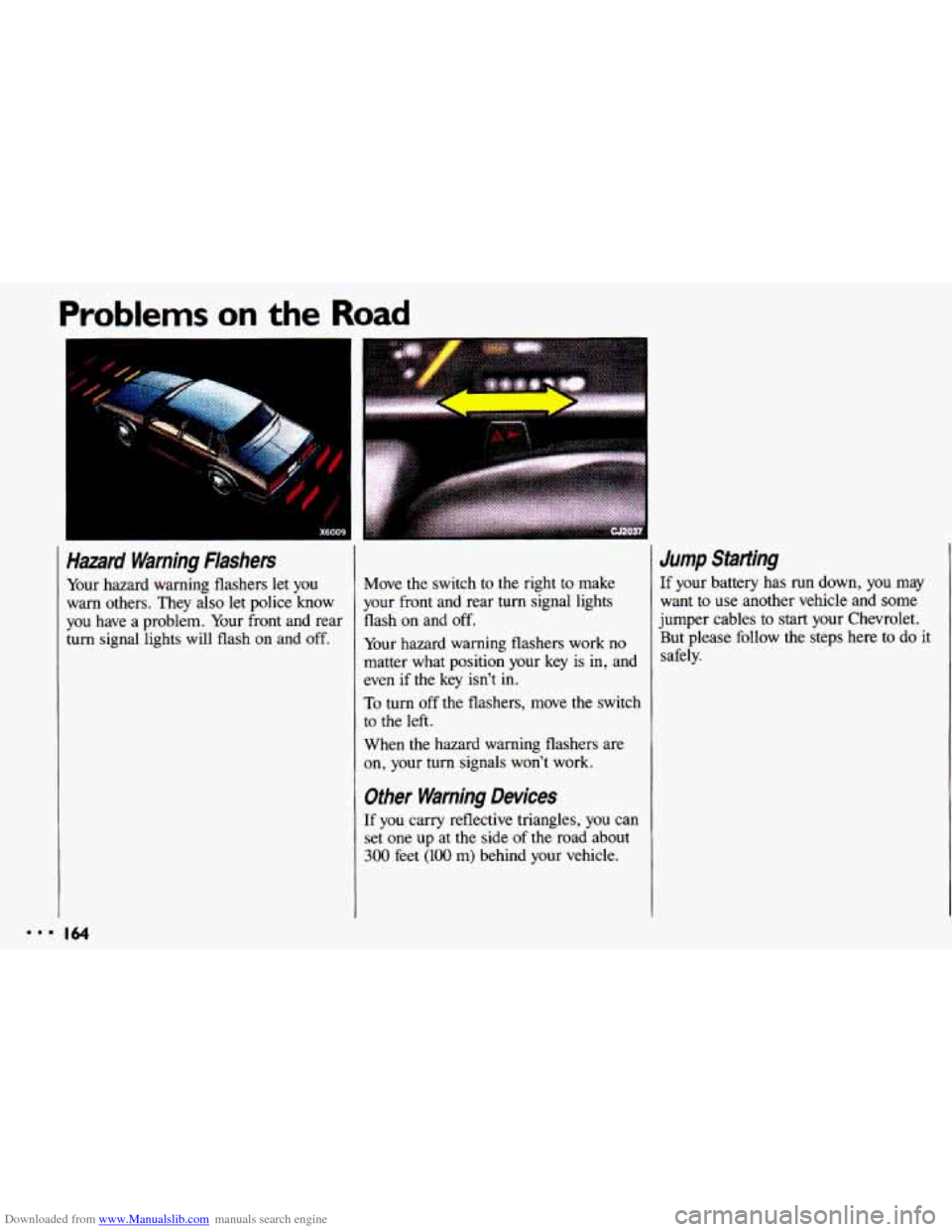
Downloaded from www.Manualslib.com manuals search engine Problems on the Road
-<.'
I X600!
Hazard Warning Flashers
Your hazard warning flashers let you
warn others. They also let police know
you have a problem. Your front and rear
turn signal lights will flash on and off. Move
the switch to the right to make
your front and rear turn signal lights
flash on and off.
Your hazard warning flashers
work no
matter what position your key
is in, and
even if the key isn't in.
To turn off the flashers, move the switch
to the left.
When the hazard warning flashers are
on, your turn signals won't work.
Other Warning Devices
If you carry reflective triangles, you can
set one up at the side of the road about
300 feet (100 m) behind your vehicle.
Jump Starling
If your battery has run down, you may
want to use another vehicle and some
jumper cables
to start your Chevrolet.
But please follow the steps here to do it
safely.
Page 167 of 308
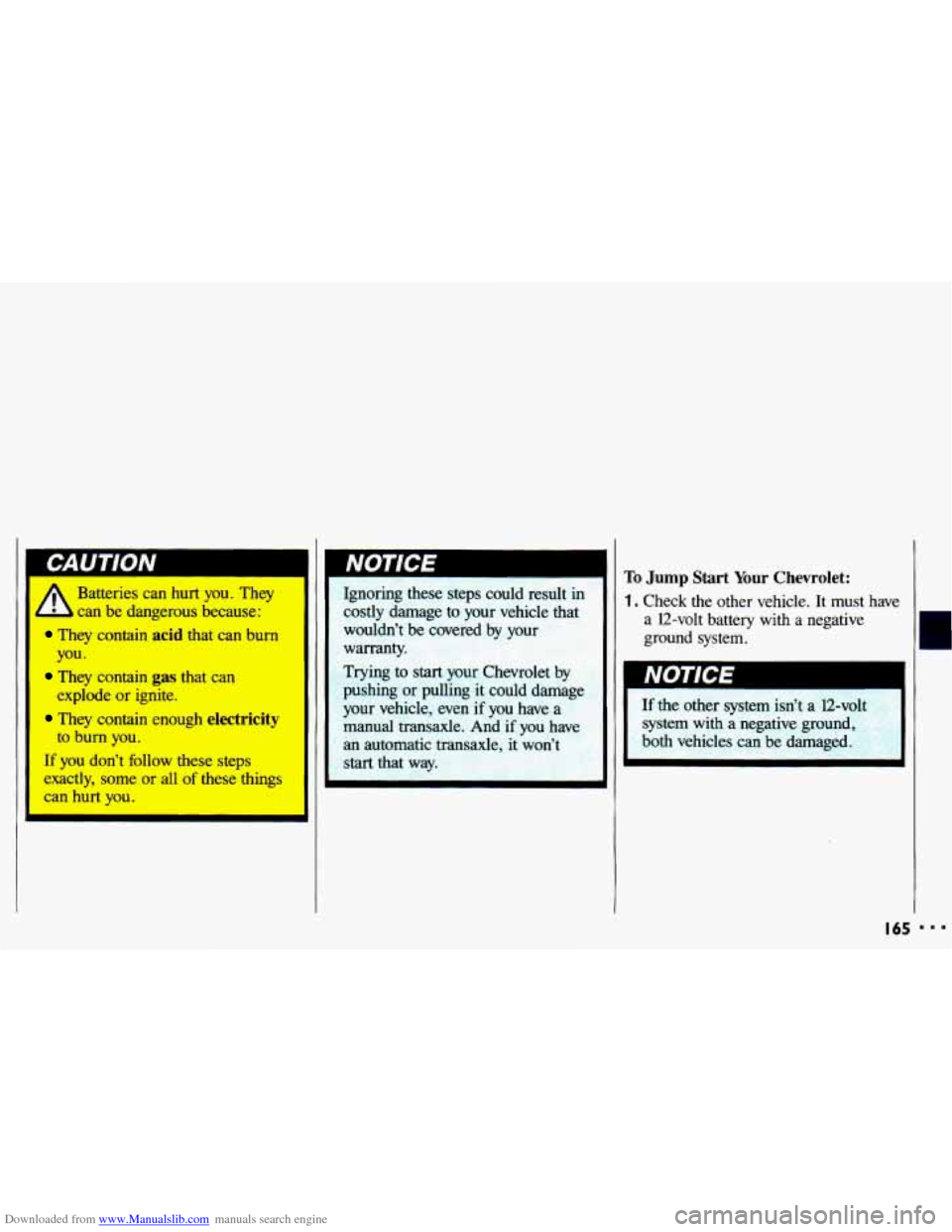
Downloaded from www.Manualslib.com manuals search engine Batteries can hurt you. They
- b can be dangerous because:
They contain acid that can burn
They contain gas that can
They contain enough electricity
If you don’t follow these steps
exactly, some or
all of these things
can hurt you.
you.
explode
or ignite.
to burn you. Ignoring these
steps could result in
costly damage to your vehicle that
wouldn’t be wered by your
warranty.
Trying
to st your Chevrolet by
pushing
or pulling it could damage
your vehicle, even if you have
a
manual transaxle. And if you ha---
an automatic transaxle, it won’t
start that way.
To Jump Start Your Chevrolet:
1. Check the other vehicle. It must have
a 12-volt battery with a negative
ground system.
If the other system isn’t a 12-volt
system with a negative ground,
both vehicles can be damaged.
NOTICE I
I65 ...
Page 168 of 308
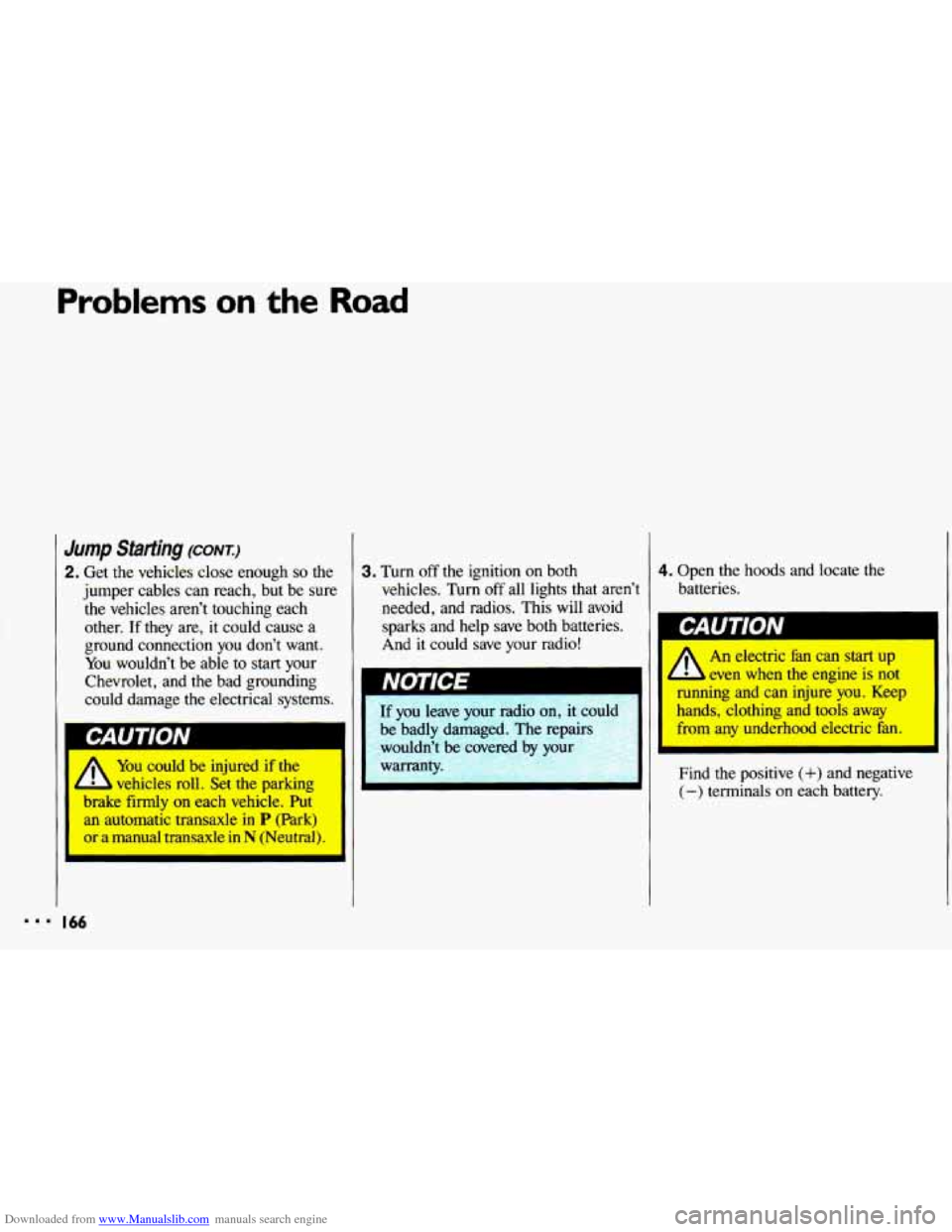
Downloaded from www.Manualslib.com manuals search engine Problems on the Road
Jump Starting (CONT:)
2. Get the vehicles close enough so the
jumper cables can reach, but be sure
the vehicles aren’t touching each
other.
If they are, it could cause a
ground connection
you don’t want.
You wouldn’t be able to start your
Chevrolet, and the bad grounding
could damage the electrical systems.
I
A You could be injured if the
vehicles roll. Set
the parking
brake
firmly on each vehicle. Put
an automatic transaxle in P (Park)
or a manual transaxle in N (Neutral).
3. Turn off the ignition on both
vehicles. Turn off all lights that aren’t
needed, and radios. This
will avoid
sparks and help save both batteries.
And it could save your radio!
If you leave your radio on, it could
be badly damaged. The repairs wouldn’t be covered by
you-
warranty.
4. Open the hoods and locate the
batteries.
I
1 An electric fan can start up I I
even when the engine is not
running and can injure you. Keep
Find the positive
(+) and negative
(-) terminals on each battery.
Page 170 of 308
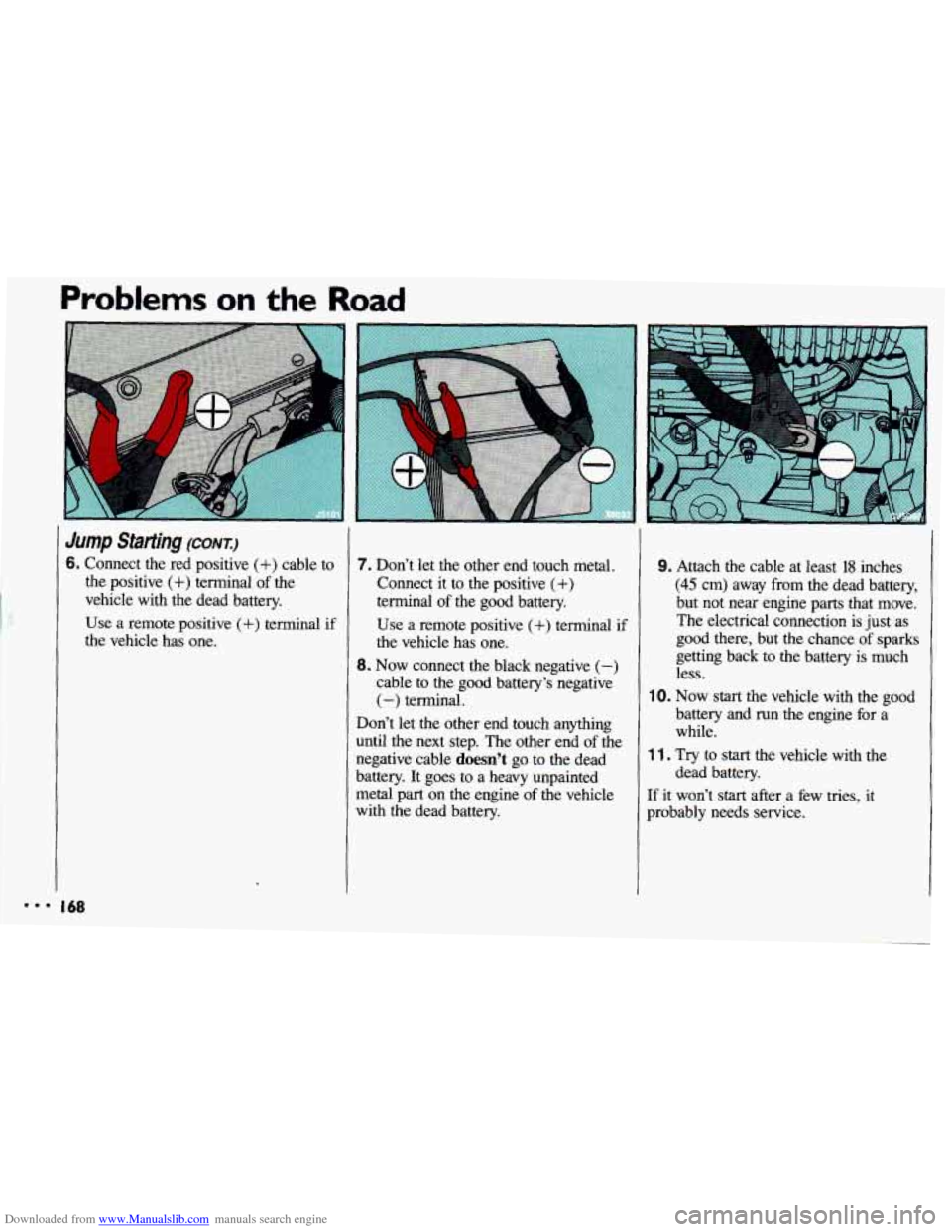
Downloaded from www.Manualslib.com manuals search engine Problems on the Road
Jump Starting (conrr.)
6. Connect the red positive (+) cable to
the positive
(+) terminal of the
vehicle with the dead battery.
Use a remote positive (+) terminal if
the vehicle has one.
7. Don’t let the other end touch metal.
Connect it to the positive
(+)
terminal of the good battery.
Use a remote positive
(+) terminal if
the vehicle has one.
6. Now connect the black negative (-)
cable to the good battery’s negative
(-) terminal.
Don’t let the other end touch anything
until
the next step. The other end of the
negative cable
doesn’t go to the dead
battery. It goes to a heavy unpainted
metal part on the engine of the vehicle
with the dead battery.
9. Attach the cable at least 18 inches
(45 cm) away from the dead battery,
but not near engine parts that move.
The electrical connection is just as
good there, but the chance of sparks
getting back to the battery is much
less.
10. Now start the vehicle with the good
battery and run the engine for a
while.
1 1. Try to start the vehicle with the
dead battery.
If it won’t start after a few tries, it
probablv needs service.
Page 225 of 308
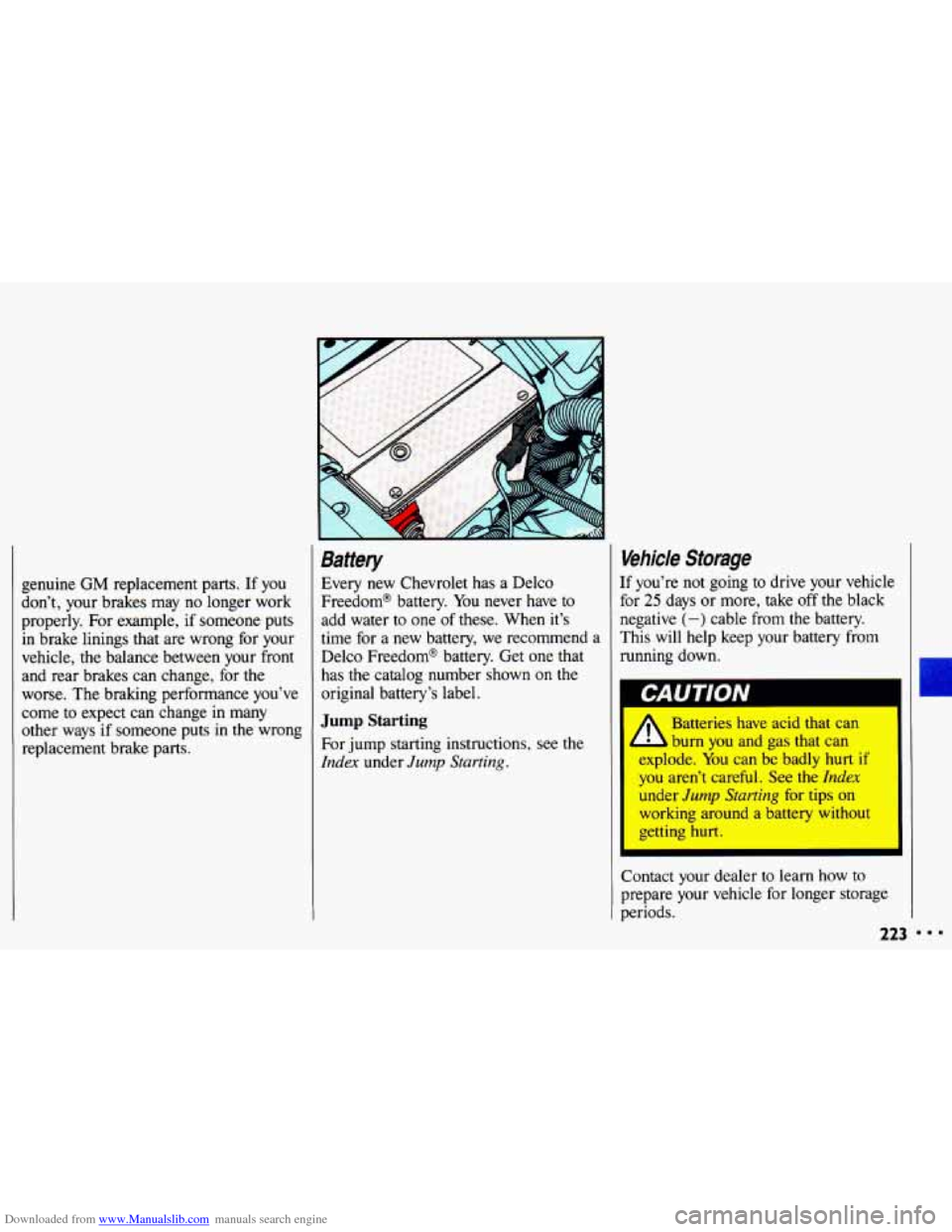
Downloaded from www.Manualslib.com manuals search engine genuine GM replacement parts. If you
don’t, your brakes may no longer work
properly. For example, if someone puts
in brake linings that are wrong for your
vehicle, the balance between your front
and rear brakes can change, for the
worse. The braking performance you’ve
come to expect can change
in many
other ways
if someone puts in the wrong
replacement brake parts.
Battery
Every new Chevrolet has a Delco
Freedom@ battery.
You never have to
add water to one
of these. When it’s
time for a new battery, we recommend a
Delco Freedom@ battery. Get one that
has the catalog number shown on the
original battery’s label.
Jump Starting
For jump starting instructions, see the
Index under Jump Starting.
Vehicle Storage
If you’re not going to drive your vehicle
for
25 days or more, take off the black
negative
(-) cable from the battery.
This will help keep your battery from
running down.
I
I A Batteries have acid that can
L burn you and gas that can
explode.
You can be badly hurt if
you aren’t careful. See the Index
under Jump Starting for tips on
working around a battery without
getting hurt.
Contact your dealer to learn how to
prepare your vehicle for longer storage
periods.
223 DDD
Page 297 of 308
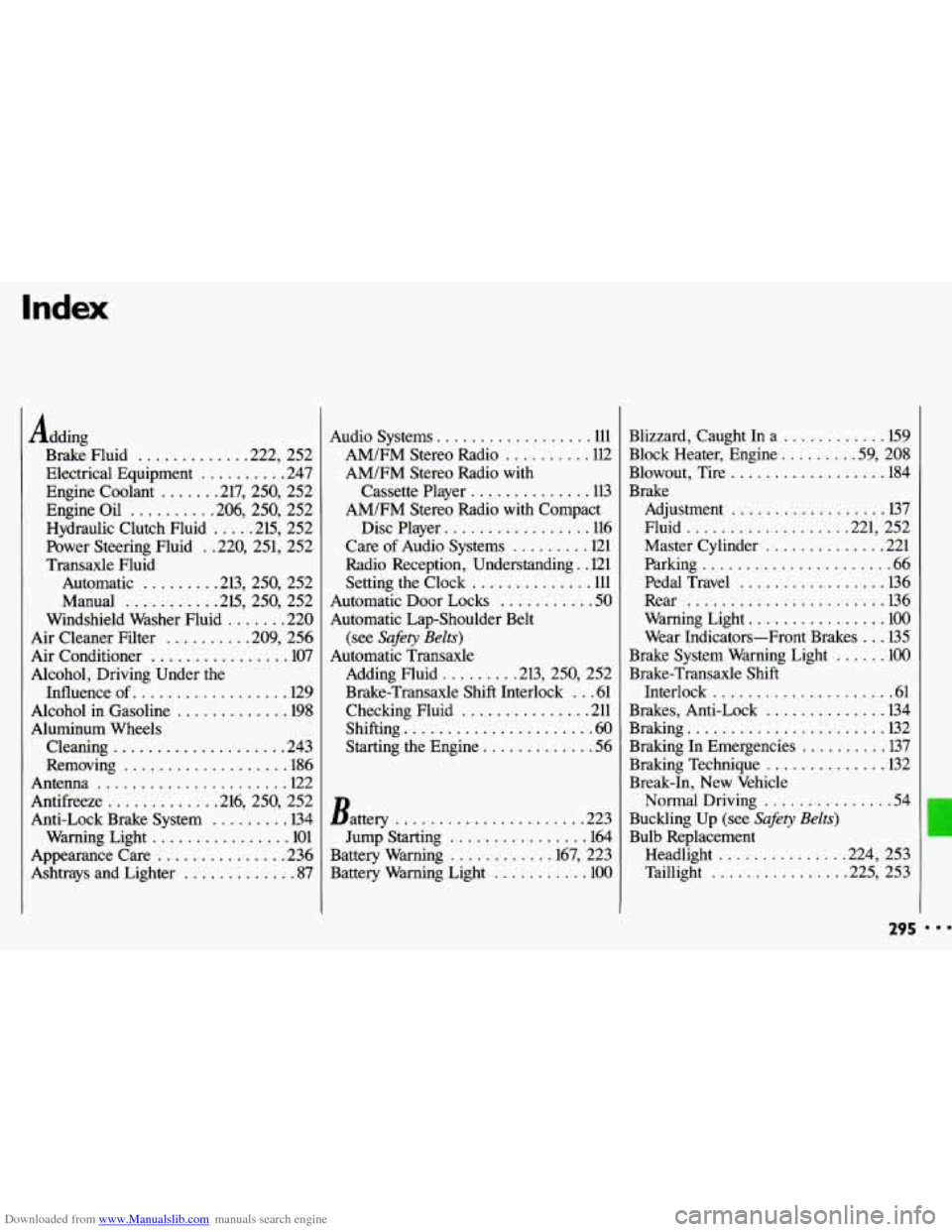
Downloaded from www.Manualslib.com manuals search engine Index
Adding Brake Fluid
............ .222. 252
Electrical Equipment
.......... 247
Engine Coolant
...... .217. 250. 252
Engine Oil
......... .206. 250. 252
Hydraulic Clutch Fluid
.... .2l5. 252
Power Steering Fluid
. .220. 251. 252
Transaxle Fluid Autornatic
........ .213. 250. 252
Manual
.......... .2l5. 250. 252
Windshield Washer Fluid
....... 220
Air Cleaner Filter
......... .209. 256
Air Conditioner
................ 107
Alcohol. Driving Under the Influence of
.................. 129
Alcohol in Gasoline
............. 198
Aluminum Wheels
Cleaning
.................... 243
Removing
................... 186
Antenna
...................... 122
Antifreeze
............ .216. 250. 252
Anti-Lock Brake System
......... 134
Warning Light
................ 101
Appearance Care
............... 236
Ashtrays and Lighter
............. 87
Audio Systems .................. 111
AM/FM Stereo Radio
.......... 112
AM/FM Stereo Radio with
Cassette Player
.............. 113
AM/FM Stereo Radio with Compact
Disc Player
................. 116
Care
of Audio Systems ......... 121
Radio Reception. Understanding
. . 121
Setting the Clock
.............. 111
Automatic Door Locks
........... 50
Automatic Lap-Shoulder Belt
(see
Safety Belts)
Automatic Transaxle
Adding Fluid
........ .213, 250, 252
Brake-Transaxle Shift Interlock
... 61
Checking Fluid
............... 211
Shifting
...................... 60
Starting the Engine ............. 56
Battery ...................... 223
Jump Starting
................ 164
Battery Warning
........... .167. 223
Battery Warning Light
........... 100 Blizzard. Caught
In a
............ 159
Block Heater. Engine
........ .59. 208
Blowout. Tire
.................. 184
Brake Adjustment
.................. 137
Fluid
.................. .221. 252
Master Cylinder
.............. 221
Parking
...................... 66
Pedal Travel
................. 136
Rear
....................... -136
Warning Light ................ 100
Wear Indicators-Front Brakes ... 135
Brake System Warning Light
...... 100
Brake-Transaxle Shift
Interlock
..................... 61
Brakes. Anti-Lock
.............. 134
Braking
....................... 132
Braking In Emergencies
.......... 137
Braking Technique
.............. 132
Break-In. New Vehicle
Normal Driving ............... 54
Buckling Up (see
Safety Belts)
Bulb Replacement
Headlight
.............. .224. 253
Taillight
............... .225. 253
295